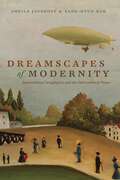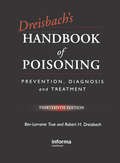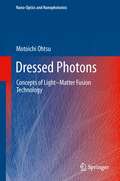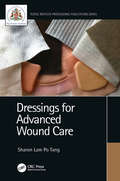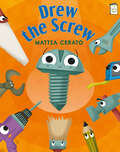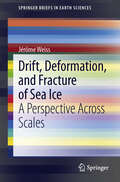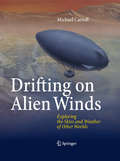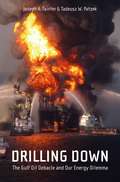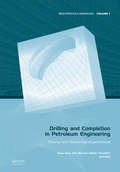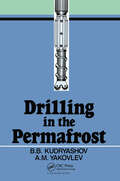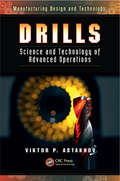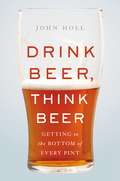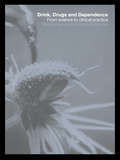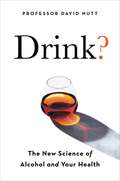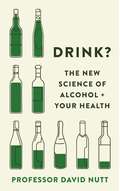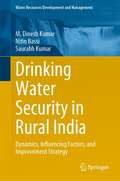- Table View
- List View
Dreamscapes of Modernity: Sociotechnical Imaginaries and the Fabrication of Power
by Sheila Jasanoff Sang-hyun KimDreamscapes of Modernity offers the first book-length treatment of sociotechnical imaginaries, a concept originated by Sheila Jasanoff and developed in close collaboration with Sang-Hyun Kim to describe how visions of scientific and technological progress carry with them implicit ideas about public purposes, collective futures, and the common good. The book presents a mix of case studies—including nuclear power in Austria, Chinese rice biotechnology, Korean stem cell research, the Indonesian Internet, US bioethics, global health, and more—to illustrate how the concept of sociotechnical imaginaries can lead to more sophisticated understandings of the national and transnational politics of science and technology. A theoretical introduction sets the stage for the contributors’ wide-ranging analyses, and a conclusion gathers and synthesizes their collective findings. The book marks a major theoretical advance for a concept that has been rapidly taken up across the social sciences and promises to become central to scholarship in science and technology studies.
Dreisbach's Handbook of Poisoning: Prevention, Diagnosis and Treatment, Thirteenth Edition
by Bev-Lorraine True Robert H. DreisbachNow in its thirteenth edition, Dreisbach's Handbook of Poisoning is long established as the definitive handbook of poisoning for all physicians, nurses, crisis and hotline workers, paramedics, and students. Rapid response is critical during the initial management of poison cases. This ready-reference guide provides antidotes, antivenins, and more f
Dressed Photons
by Motoichi OhtsuAuthored by the developer of dressed photon science and technology as well as nanophotonics, this book outlines concepts of the subject using a novel theoretical framework that differs from conventional wave optics. It provides a quantum theoretical description of optical near fields and related problems that puts matter excitation such as electronic and vibrational ones on an equal footing with photons. By this description, optical near fields are interpreted as quasi-particles and named dressed photons which carry the material excitation energy in a nanometric space. The author then explores novel nanophotonic devices, fabrications, and energy conversion based on the theoretical picture of dressed photons. Further, this book looks at how the assembly of nanophotonic devices produces information and communication systems. Dressed photon science and technology is on its way to revolutionizing various applications in devices, fabrications, and systems. Promoting further exploration in the field, this book presents physically intuitive concepts, theories, and technical details for students, engineers, and scientists engaged in research and development in dressed photon science and technology as well as nanophotonics.
Dressed Photons to Revolutionize Modern Physics: Exploring Longitudinal Electromagnetic Waves and Off-Shell Quantum Fields (Nano-Optics and Nanophotonics)
by Motoichi Ohtsu Hirofumi SakumaThis book presents an in-depth review of the recent interdisciplinary studies that have shed light on the mechanisms of the creation, energy transfer, and measurement of the dressed photon. A dressed photon is a type of photon that results from the interaction between light and matter in a confined space, typically on the scale of nanometers. It has been applied to nano-fabrication technologies, energy conversion technologies, and silicon light-emitting devices. Despite its extensive applications in various fields, the dressed photon's off-shell nature has posed challenges in describing it through conventional optical scientific theories. The book explains how, through a mathematical viewpoint, the underlying spatiotemporal vortex dynamics connect the dressed photon, the dark energy field, and the structure of the universe. The canonical equations of motion, which describe the time evolution of dynamical systems with Hamiltonian structure, play a key role in understanding these physical phenomena. In particular, the covariant form of equations of motion, where vortex tensors explicitly appear, corresponds to the transformed canonical equations of motion in the Eulerian representation. This newly augmented view of the equations of motion presents a deeper understanding of the interconnectedness of different physical phenomena, which can enlighten graduate students, junior scientists, and industry engineers engaged or interested in this field.
Dressings for Advanced Wound Care (Textile Institute Professional Publications)
by Sharon Lam TangDressings for Advanced Wound Care focuses on helping the reader better understand advanced wound care and relevant technologies. It explains how different types of wounds may require different environments to heal and how dressings can help in creating the right environment. It gives an overview of the various dressing technologies that are available to help manage wounds that are difficult to heal. Finally, this book highlights the current trends that may be directing the future of the advanced wound dressing sector. FEATURES: Relates technologies with commercially available end-products, giving the reader a more specific overview of the advanced wound dressing sector Provides a realistic overview of the process of developing an advanced wound care dressing Summarises recent clinical evidence on advanced wound dressings Explains how dressings differ and what works best for which wound type Examines clinical evidence on technologies and on-market products Describes the requirements for launching a new advanced wound dressing This book is aimed at medical clinicians and professionals in the fields of biomedical engineering, textile science, and materials engineering.
Drew the Screw (I Like to Read)
by Mattia CeratoEvery tool has a job—but what can Drew the Screw do? Find out in this Level E reader, perfect for Kindergarten and first-grade readers. The pencil draws lines. The saw can cut. But unlike everyone else in the toolshed, Drew the screw has no job. He watches as one by one the tools show off their skills . . . and then he finds his own hidden talent, holding up a Home, Sweet Home sign in a newly-built treehouse. Bright digital drawings of cartoonish tools happily going about their jobs are paired with a very simple text, appropriate for children just beginning to read on their own. Explore all the different things tools can do—and the joy of finding your own special talents!—with Drew. The award-winning I Like to Read® series focuses on guided reading levels A through G, based upon Fountas and Pinnell standards. Acclaimed author-illustrators--including winners of Caldecott, Theodor Seuss Geisel, and Coretta Scott King honors—create original, high quality illustrations that support comprehension of simple text and are fun for kids to read with parents, teachers, or on their own! Level E stories feature a distinct beginning, middle, and end, with kid-friendly illustrations offering clues for more challenging sentences. Varied punctuation and simple contractions may be included. Level E books are suitable for early first graders. When Level E is mastered, follow up with Level F.
Dried Blood Spots: Applications and Techniques (Wiley Series on Pharmaceutical Science and Biotechnology: Practices, Applications and Methods)
by Mike S. Lee Wenkui LiAn informative and comprehensive book on the applications and techniques of dried blood spot sampling Dried blood spot (DBS) sampling involves the collection of a small volume of blood, via a simple prick or other means, from a study subject onto a cellulose or polymer paper card, which is followed by drying and transfer to the laboratory for analysis. For many years, this method of blood sample collection has been extensively utilized in some important areas of human healthcare (for example, newborn screening for inherited metabolic disorders and HIV-related epidemiological studies). Because of its advantages over conventional blood, plasma, or serum sample collection, DBS sampling has been valued by the pharmaceutical industry in drug research and development. Dried Blood Spots: Applications and Techniques features contributions from an international team of leading scientists in the field. Their contributions present a unique resource on the history, principles, procedures, methodologies, applications, and emerging technologies related to DBS. Presented in three parts, the book thoroughly examines: Applications of DBS sampling and associated procedures and methodologies in various human healthcare studies Applications and perspectives of DBS sampling in drug research and development, and therapeutic drug monitoring New technologies and emerging applications related to DBS sampling and analysis Dried Blood Spots: Applications and Techniques is a valuable working guide for researchers, professionals, and students in healthcare, medical science, diagnostics, clinical chemistry, and pharmaceuticals, etc.
Drift, Deformation, and Fracture of Sea Ice
by Jérôme WeissSea ice is a major component of polar environments, especially in the Arctic where it covers the entire Arctic Ocean throughout most of the year. However, in the context of climate change, the Arctic sea ice cover has been declining significantly over the last decades, either in terms of its concentration or thickness. The sea ice cover evolution and climate change are strongly coupled through the albedo positive feedback, thus possibly explaining the Arctic amplification of climate warming. In addition to thermodynamics, sea ice kinematics (drift, deformation) appears as an essential factor in the evolution of the ice cover through a reduction of the average ice age (and consequently of the cover's thickness), or ice export out of the Arctic. This is a first motivation for a better understanding of the kinematical and mechanical processes of sea ice. A more upstream, theoretical motivation is a better understanding of the brittle deformation of geophysical objects across a wide range of scales. Indeed, owing to its very strong kinematics, compared e.g. to the Earth's crust, an unrivaled kinematical data set is available for sea ice from in situ (e.g. drifting buoys) or satellite observations. Here, we review the recent advances in the understanding of sea ice drift, deformation and fracturing obtained from these data. We focus particularly on the scaling properties in time and scale that characterize these processes, and we emphasize the analogies that can be drawn from the deformation of the Earth's crust. These scaling properties, which are the signature of long-range elastic interactions within the cover, constrain future developments in the modeling of sea ice mechanics. We also show that kinematical and rheological variables such as average velocity, average strain-rate or strength have significantly changed over the last decades, accompanying and actually accelerating the Arctic sea ice decline.
Drifting on Alien Winds
by Michael CarrollEver since the Montgolfier's hot air balloon carried a chicken, a goat, and a duck into the Parisian skies, scientists have dreamed of contraptions to explore the atmosphere. With the advent of the space age, new airborne inventions were needed. From the Soviet Venus balloons to the advanced studies of blimps and airplanes for the atmospheres of Mars and Titan, Drifting on Alien Winds surveys the many creative and often wacky ideas for exploring alien skies. Through historical photographs and stunning original paintings by the author, readers also explore the weather on planets and moons, from the simmering acid-laden winds of Venus to liquid methane-soaked skies of Titan.
Drilling Down
by Joseph A. Tainter Tadeusz W. PatzekFor more than a century, oil has been the engine of growth for a society that delivers an unprecedented standard of living to many. We now take for granted that economic growth is good, necessary, and even inevitable, but also feel a sense of unease about the simultaneous growth of complexity in the processes and institutions that generate and manage that growth. As societies grow more complex through the bounty of cheap energy, they also confront problems that seem to increase in number and severity. In this era of fossil fuels, cheap energy and increasing complexity have been in a mutually-reinforcing spiral. The more energy we have and the more problems our societies confront, the more we grow complex and require still more energy. How did our demand for energy, our technological prowess, the resulting need for complex problem solving, and the end of easy oil conspire to make the Deepwater Horizon oil spill increasingly likely, if not inevitable? This book explains the real causal factors leading up to the worst environmental catastrophe in U.S. history, a disaster from which it will take decades to recover.
Drilling Engineering Problems and Solutions: A Field Guide for Engineers and Students (Wiley-Scrivener)
by M. R. Islam M. E. HossainPetroleum and natural gas still remain the single biggest resource for energy on earth. Even as alternative and renewable sources are developed, petroleum and natural gas continue to be, by far, the most used and, if engineered properly, the most cost-effective and efficient, source of energy on the planet. Drilling engineering is one of the most important links in the energy chain, being, after all, the science of getting the resources out of the ground for processing. Without drilling engineering, there would be no gasoline, jet fuel, and the myriad of other “have to have” products that people use all over the world every day. Following up on their previous books, also available from Wiley-Scrivener, the authors, two of the most well-respected, prolific, and progressive drilling engineers in the industry, offer this groundbreaking volume. They cover the basics tenets of drilling engineering, the most common problems that the drilling engineer faces day to day, and cutting-edge new technology and processes through their unique lens. Written to reflect the new, changing world that we live in, this fascinating new volume offers a treasure of knowledge for the veteran engineer, new hire, or student. This book is an excellent resource for petroleum engineering students, reservoir engineers, supervisors & managers, researchers and environmental engineers for planning every aspect of rig operations in the most sustainable, environmentally responsible manner, using the most up-to-date technological advancements in equipment and processes.
Drilling Wastes
by John R. Wilson Sarah SharplesProceedings of the 1988 International Conference on Drilling Wastes, Calgary, Alberta, Canada, 5-8 April 1988.
Drilling and Completion in Petroleum Engineering: Theory and Numerical Applications (Multiphysics Modeling)
by Xinpu Shen William Standifird Mao BaiModern petroleum and petrotechnical engineering is increasingly challenging due to the inherently scarce and decreasing number of global petroleum resources. Exploiting these resources efficiently will require researchers, scientists, engineers and other practitioners to develop innovative mathematical solutions to serve as basis for new asset deve
Drilling in the Permafrost: Russian Translations Series, volume 84
by B.B. Kudyashov A.M. YakovlevFirst published in 1991. This volume presents a brief description of the natural conditions of the permafrost regions, the properties of the permafrost and the processes occurring in it, the fundamentals of the heat transfer processes during drilling and the service temperature conditions of the tool. Methods and devices for cooling the flushing media, principles of quality control of flushing agents and the technology and commercial viability of their use during drilling in the permafrost have been considered. The main emphasis in this book is on the drilling technology which uses a variety of flushing agents. The text also includes a description of the technology of utilizing grouting solutions, the theory and practice of drilling with simultaneous freezing of weakly cohesive, moist ground as well as jdrilling holes in the ice-sheets of the circumpolar regions. This book is intended for engineers and technical personnel engaged in drilling for exploratory geological works.
Drills: Science and Technology of Advanced Operations
by Viktor P. AstakhovIn a presentation that balances theory and practice, Drills: Science and Technology of Advanced Operations details the basic concepts, terminology, and essentials of drilling. The book addresses important issues in drilling operations, and provides help with the design of such operations. It debunks many old notions and beliefs while introducing sc
Drink Beer, Think Beer: Getting to the Bottom of Every Pint
by John HollFrom an award-winning journalist and beer expert, a thoughtful and witty guide to understanding and enjoying beerRight here, right now is the best time in the history of mankind to be a beer drinker. America now has more breweries than at any time since prohibition, and globally, beer culture is thriving and constantly innovating. Drinkers can order beer brewed with local yeast or infused with moondust. However, beer drinkers are also faced with uneven quality and misinformation about flavors. And the industry itself is suffering from growing pains, beset by problems such as unequal access to taps, skewed pricing, and sexism. Drawing on history, economics, and interviews with industry insiders, John Holl provides a complete guide to beer today, allowing readers to think critically about the best beverage in the world. Full of entertaining anecdotes and surprising opinions, Drink Beer, Think Beer is a must-read for beer lovers, from casual enthusiasts to die-hard hop heads.
Drink, Drugs and Dependence: From Science to Clinical Practice
by Woody Caan Jackie De BellerocheAt a world level addiction and the fall-out from substance use is affecting more and more lives. Professionals are increasingly being confronted with puzzling, multifaceted aspects of substance use, whether they work in a clinic, the laboratory or the community.If you are a member of any caring profession, sooner or later you will encounter problems caused by drugs, alcohol and tobacco. In order to understand substance use and substance users, no single discipline can provide all the answers. In a novel way, this book integrates biological science, social science and clinical experience. It draws together contributions from experts in these diverse and rapidly growing fields, providing the reader with a deeper capacity to engage with problems effectively.Drink, Drugs and Dependence includes thought-provoking examples, illustrations and test questions to support problem-based learning. Designed to be read consecutively or as a reference text, it will be a welcome resource for all those working in the field of addiction.
Drink?: The New Science of Alcohol and Health
by Professor David NuttA world-renowned authority on the science of alcohol exposes its influence on our health, mood, sleep, emotions, and productivity -- and what we can and should do to moderate our intake.From after-work happy hour to a nightly glass of wine, we're used to thinking of alcohol as a normal part of our daily lives. In Drink?, neuropharmacology professor David Nutt takes a fascinating, science-based look at drinking to unpack why we should reconsider our favorite pastime.Using cutting-edge scientific research and years of hands-on experience in the field, Nutt delves into the long- and short-term effects of alcohol. He addresses topics such as hormones, mental health, fertility, and addiction, explaining how alcohol travels through our bodies and brains, what happens at each stage of inebriation, and how it effects us even after it leaves our systems. With accessible, easy-to-understand language, Nutt ensures that readers recognize why alcohol can have such a negative influence on our bodies and our society. In the vein of This Naked Mind,Drink? isn't preachy; it simply gives readers clear, evidence-based facts to help them make the most informed choices about their consumption.
Drink?: The New Science of Alcohol and Your Health
by Professor David NuttTHE DEFINITIVE GUIDE TO ALCOHOL AND YOUR HEALTHAlcohol - a simple molecule that can induce so much pleasure and pain at the same time... As the most harmful drug in the UK, it has a profound and wide-reaching impact on our health and on society at large. Drink? is the first book of its kind, written by a scientist and rooted in 40 years of medical research and hands-on experience treating patients. Professor David Nutt cuts through the noise to explain the long- and short-term effects of alcohol, makes complex science digestible and takes readers through its journey inside the body and brain from the very first sip.Drink? holds the key to all the questions you want to know the answers to, covering mental health, sleep, hormones, fertility and addiction. It sheds light on what 'responsible drinking' truly means and equips us with the essential knowledge we all need to make rational, informed decisions about our consumption now and in the future.
Drink?: The New Science of Alcohol and Your Health
by Professor David NuttWorld-renowned Professor of Neuropsychopharmacology, David Nutt - breaks down the science and effect of alcohol on our health, mood, sleep, productivity, how it travels through our bodies and brains - and explains on a practical level how we can make changes to positively impact our relationship with it and understanding of it; thereby improving our quality of life for the long-term.He will examine what the future holds for this normalised drug that governs our society and lives but is becoming increasingly unpopular due to its detrimental impact on our wellbeing. Booze Control will do what Matthew Walker did for Sleep and Giulia Enders did for our Gut - and help us make informed choices, at the very least. David will illuminate our minds on this important and timely subject.(P) 2020 Hodder & Stoughton Ltd
Drinking Water Chemistry: A Laboratory Manual
by Barbara HauserWhether you are a new employee or seasoned professional you need easy access to the latest test methods, updated quality control procedures, and calculations at your fingertips. You need to perform analyses quickly and easily and troubleshoot problems as they arise. You need a resource that is not only informative, but also practical and easy to use. Drinking Water Chemistry: A Laboratory Manual fills this need.The book gives you a thorough overview of the most basic, and therefore important, laboratory topics such as:Laboratory Safety - dos and don'ts based on real experienceSampling - preservation techniques, online sampling, and record keepingLaboratory Instruments - practical use ranges, principles of operation, calibration, conditioning, useful life and replacement, common quality control issuesChemical Use - reagents, standards, indicators, purpose and use, chemical quality and properties, avoidance of contamination, molecular weight calculationsQuality Control - replicate analyses, spiked, split, and reference samples, percent recovery of standard, standard deviation, control charts, and everyday quality control measuresWeights and Concentrations - care and analytical balances, mathematical conversions among concentration units, dilutions and concentration changesThe remaining chapters cover test analysis including: reason for the test, type of sample taken, treatment plant control significance, expected range of results, appropriate quality control procedures, apparatus used, reagents, including function, concentration and instructions for preparation, procedural steps, calculations and notes on possible problems, and references. This is a working manual, meant to be kept by your side in the lab, not on the shelf in an office or library. You can bend it, you can lay it flat, you can take it anywhere you do your job. Useful and practical Drinking Water Chemistry: A Laboratory Manual provides the information you need to perform tests, understand the results, apply them to the determination of water quality before and after treatment, and troubleshoot any problems.
Drinking Water Disinfection By-products: Sources, Fate and Remediation
by Pramod Kumar Pradeep Kumar Mishra Sirajuddin Ahmed Sughosh Madhav Mohd Aamir MazharThis book is devoted to water treatment and it outlines the historical context and regulatory framework surrounding drinking water chlorination, addressing disinfection by-products (DBPs) formation, associated challenges and implications on water quality and human health. In this book, readers will find an overview of various disinfection processes and the latest strategies in DBPs detection and remediation. Divided into 14 chapters, the book begins by offering a background analysis of water disinfection and comparing different disinfection processes and management strategies to mitigate the formation of DBPs. Particular attention is given to both conventional and non-conventional methods used to treat potable water, comparing their effectiveness and potential risks. In subsequent chapters, expert contributors outline the route of exposure and mechanism of action of DBPs, and the toxicological impact of DBPs on human health, providing essential insights for effective risk management strategies. This book also showcases the latest advancements in chlorine applications for water quality control and explores innovative physicochemical and nanotechnology-based approaches to remove DBPs and minimize their formation. Readers will also find in this book a case study of the GIS-based trends analysis of THMs compounds in Indian drinking water supplies. Given its breadth, this book is a valuable resource for researchers, academics, professionals, and policymakers working in environmental sciences, public health and water management, and interested in safer and sustainable drinking water practices.
Drinking Water Distribution Systems: Assessing And Reducing Risks
by Committee on Public Water Supply Distribution Systems: Assessing Reducing RisksProtecting and maintaining water distributions systems is crucial to ensuring high quality drinking water. Distribution systems -- consisting of pipes, pumps, valves, storage tanks, reservoirs, meters, fittings, and other hydraulic appurtenances -- carry drinking water from a centralized treatment plant or well supplies to consumers’ taps. Spanning almost 1 million miles in the United States, distribution systems represent the vast majority of physical infrastructure for water supplies, and thus constitute the primary management challenge from both an operational and public health standpoint. Recent data on waterborne disease outbreaks suggest that distribution systems remain a source of contamination that has yet to be fully addressed. This report evaluates approaches for risk characterization and recent data, and it identifies a variety of strategies that could be considered to reduce the risks posed by water-quality deteriorating events in distribution systems. Particular attention is given to backflow events via cross connections, the potential for contamination of the distribution system during construction and repair activities, maintenance of storage facilities, and the role of premise plumbing in public health risk. The report also identifies advances in detection, monitoring and modeling, analytical methods, and research and development opportunities that will enable the water supply industry to further reduce risks associated with drinking water distribution systems.
Drinking Water Minerals and Mineral Balance: Importance, Health Significance, Safety Precautions
by Ingegerd Rosborg Frantisek KozisekFollowing the successful first edition of this book on drinking water quality and health, this new edition puts more focus on the importance of minerals in drinking water. It includes new scientific material and presents additional studies on the negative health effects of reverse osmosis water. The various safety organizations working on drinking water all warn about unhealthy constituents, as well as elements that can cause corrosion or scaling on pipes and installations. However, drinking water may also provide a substantial portion of the daily mineral intake, especially for the elderly and children, or those at risk of deficiencies due to unhealthy eating habits or starvation. Thus, a holistic approach to drinking water is presented in this book and the scope is extended from standards for undesirable substances to the basic mineral composition of water, examining 22 nutrient elements and ions and 21 toxic substances. The function of the nutrients in the body, symptoms of deficiency and overload, and advantages of the minerals from drinking water are presented, as well as symptoms of toxic elements from drinking water. The authors also suggest healthy ranges of minerals and mineral ratios for drinking water. The book offers a valuable resource for the health evaluation of drinking waters, for private well owners, public water producers and safety organizations alike.
Drinking Water Security in Rural India: Dynamics, Influencing Factors, and Improvement Strategy (Water Resources Development and Management)
by Nitin Bassi M. Dinesh Kumar Saurabh KumarThis book highlights the multi-pronged strategy for achieving sustainable rural domestic water supply in India. It deepens the understanding of groundwater (predominant source of water supply) behaviour in response to natural processes in different geological settings, analyses the factors influencing the performance of water supply schemes; identifies the conditions under which groundwater-based drinking water sources become sustainable, suggests measures for improving the sustainability of drinking water wells in hard rock regions (covering 2/3rd of India’s geographical area), presents a decision-making framework for planning rural water supply schemes in the country for ensuring long-term sustainability, and suggests physical strategies and policy measures for achieving them.The analyses for development and validation of various models that explain groundwater system behaviour and performance of rural water supply schemes are undertaken for different geological settings in Maharashtra, as the state represents a microcosm of the various hydrological, topographical, and geohydrological conditions encountered in the country. The final analysis for proposing nation-wide strategies considers the various hydrological, geological, geohydrological, and topographical and climatic settings and groundwater contamination and pollution in the country.
